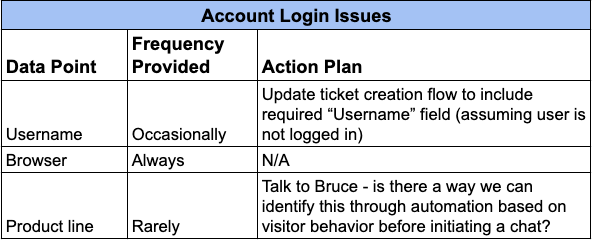When it comes to excellent customer support, resolving a customer’s issue quickly and efficiently makes all the difference. Customers don’t want to reach out again and again about the same problem. And nothing bogs down your support team’s morale, goals, and budget like low first contact resolution.
In fact, if you’re struggling with first contact resolution (FCR), you’ll notice its impacts creep into other parts of your organization, including:
- Higher support staffing costs
- Longer first response times
- Decreased customer satisfaction
- Lower customer loyalty
- Higher churn rates
That’s why it’s so important to have a high FCR. And the good news is that if you improve your FCR, it’ll have a ripple effect of positive changes throughout your customer support processes (and other metrics).
In this playbook, we’ll show you how to measure, diagnose, and improve your first contact resolution in four tangible and impactful ways.
What other metrics should you be tracking? Download our "5 Metrics Every Support Leader Should Know" guide to find out.
What is first contact resolution?
Before we get into our four-step strategy for improving first contact resolution, let’s quickly define what it is. First contact resolution (FCR) - sometimes referred to as one-touch resolution or first call resolution - measures your support team’s ability to solve customer problems in a single interaction.
A high FCR score indicates your team is operating efficiently. Not only does this help you cut staffing costs, but it also leads to increased customer satisfaction and loyalty.
Related post: Customer Service Call Scripts: Benefits, Tips, and Templates
How to measure first contact resolution
While the definition of FCR might be straightforward, capturing accurate FCR data can be another story altogether. There are a few different ways to measure FCR, and you’ll want to choose one before you start our four-step improvement plan:
Ask your customers
Asking your customers whether you successfully resolved their ticket in one try is the simplest way to capture FCR. One common way to do this is to add a question to an automated survey that goes out after you close a support ticket. Since many support teams already send surveys like this to measure customer satisfaction, it’s typically a simple change to make.
Surveying your customers is not without its pitfalls. The most obvious challenge to this method is low survey response rates. Survey response rates are typically under 30%, so it can be difficult to know whether your survey data is representative of your whole customer base.
Have your support team indicate first contact resolution
Adding a checkbox on your support ticket can be an easy way of enabling your team to track tickets that are resolved on first contact. If an agent believes the issue was resolved upon first contact, they simply check the box before closing the ticket. The results are easy to aggregate and report on.
The biggest challenge to tracking first contact resolution this way is that your support team may not always accurately indicate if a ticket was resolved on first contact (accidentally or intentionally). Doing regular audits of this field on a subset of your tickets can help mitigate this problem, but that means more work for you or a member of your team.
Use a formula
The simplest formula for measuring FCR is the number of tickets resolved at first contact divided by the total number of tickets.
The challenge with this approach is that there are many factors to consider, and there is no standard formula used across industries. Some of the factors you’ll need to consider when you tailor your approach include:
- What does it mean for a ticket to be resolved?
- What channels will be included?
- Are abandoned calls included?
- How do escalated tickets impact FCR?
- If a customer contacts you again in the near future about a related issue, how do you decide if that’s a “new” issue or if it negates FCR on the original issue?
While having several different ways to measure first contact resolution may seem intimidating, it’s important to pick an approach and stick with it. Measuring FCR in a consistent manner over time will enable you to understand your baseline and set a clear goal for your team.
As you set a goal, remember that FCR is important to view as an organization-wide goal, because your product experience can influence FCR in ways that individual agents will be unable to control - so make sure you share results with the leadership team.
Once you decide how you want to measure first contact resolution, implement this four-step plan to help you improve it.
Related post: 10 Customer Intimacy Strategies to Drive Higher Revenue
1. Analyze delayed tickets
Gather all of your tickets that required more than one interaction, and analyze them for any patterns that occur repeatedly.
If your support team is tagging tickets, this can be fairly easy to do. You may see certain tags appear in much higher volume than others. Those tags should immediately go on your list of areas to explore in more depth.
Another great approach is to compare the prevalence of specific tags in your “delayed ticket” bucket with the prevalence of the same tags in your total ticket count. For example, if 85% of your delayed tickets are tagged “Account Login Issue,” yet these tickets only make up 10% of your total ticket volume, it’s a clear indicator that these tickets are having an outsized effect on your FCR rate.
As you’re examining your tickets, you’ll probably find that most tickets not solved on the first contact fall into two buckets:
- The customer didn’t provide enough information to act
- The agent didn’t have the training or tools to resolve the issue
Target each of these buckets, and you’ll start to realize the benefits of a high first contact resolution rate.
2. Collect the right information up front
To resolve your customers’ problems, you’ll need to start with the right information. If you can’t list those required data points off the top of your head, make some time to quantify those items.
Try this:
- Identify the top 10 ticket types you’d like to drill into. Remove any that aren’t FCR candidates.
- For each ticket type, list out the minimum information required to resolve the issue.
- Label each item according to how regularly it’s provided upfront (eg. reliably-provided, occasionally-provided, or rarely-provided.)
- Move the rarely- or occasionally-provided data points to the reliably-provided category by adding them to forms or prompts at ticket submission.
Long story short, think of the ticket types you get frequently that should be resolved on first contact. Look at all the first responses and the questions your agents asked. Then put those questions in a form instead.
Here’s what that might look like:

There is an important tension to be aware of when working through this exercise. Namely, you want to capture all necessary data upfront as often as you can without significantly increasing the effort for your customers.
The best way to do this is often through leveraging technology to capture and share relevant data with your support team. For example, Stonly empowers your team by capturing and sharing which guides a customer has viewed and which steps they have completed prior to contacting your support team:
Don’t make your customers go through a 12-step process to get in contact with your support team. They’ll be unhappy and frustrated, and even your best efforts to resolve tickets on first contact likely won’t change that. Intelligent use of the right technology can boost your FCR rates without increasing customer effort, giving you a more efficient support team and a better customer experience.
3. Train and equip your support team
If your support team is going to resolve issues efficiently, they need to know how to find the right answers as quickly as possible—every time. Empower your agents by embedding interactive agent guides directly into your CRM and offering regular training.
This highlights another reason why analyzing your delayed tickets is so critical: it helps uncover training opportunities.
Training for first contact resolution
You’ll typically find two different categories of training needed:
Product training. Every support team has to deal with rapidly changing products. If your product team is regularly releasing product enhancements and updates, you need to find a reliable way to make sure your support team stays current on product changes. You can accomplish this through sharing release notes, regular product updates, or a quality knowledge base (or a combination of all three).
What’s important is ensuring your support team has sufficient product knowledge to serve your customers well. No support agent will know every detail, so product knowledge availability - typically achieved with a knowledge base - is also important to keep in mind.
Don’t forget that your support team often functions as a catch-all for other random questions, as well. To this end, make sure they’re in-the-know on things like new marketing efforts and sales initiatives.
Skill training. Providing efficient support is a skill. Giving any agent the right tools and information is valuable. But if you can also arm them with the skills to cut through confusion and uncover what your customer really needs, you’ll be well on your way to victory.
As a start, consider providing additional training opportunities for your support team in active listening and asking good questions. Skills like these enable support agents to quickly understand what customers need and deliver high-quality, efficient customer service.
4. Give your support team the right tech
It’s not uncommon for support teams to get stuck using outdated technology. A technology audit can shed light on ways your tech might be hampering your first contact resolution efforts. Here are a few places to start:
Make customer data easily accessible
You need to collect the right information from the customer, but you also need to eliminate any siloes you’ve constructed internally. The best place to start is by looking at your CRM or help desk software. What sort of integrations do you have in place? Can your support team access a customer’s history when they reach out for help? Can they tell where a customer is at in their journey? Don’t let your support team or your customers suffer because important information is buried in siloed systems.
Leverage your help center effectively
Customers love self-service. But did you know that a thorough help center can also help you improve your FCR rate? When your customers reach out for help, a great help center enables your support team to send them a link to an article with detailed instructions, multimedia, and next steps already laid out. It’s a fantastic way to help customers at scale, maintain a high FCR, and limit your support costs.
Assess your ticket routing
If a customer with an issue gets routed to the wrong team or agent, you’ve just blown your chance to resolve the ticket on your first attempt. Look at each of your support channels, and ask yourself whether tickets could be more effectively routed to the appropriate people.
Take the initiative to improve your first contact resolution
FCR is a powerful driver of customer success and customer loyalty. It’s a well-proven metric used by support teams around the world, for good reason. By engaging in the recommended strategies above, you’ll be taking deliberate action that will make life easier for your customers and will propel you towards long-term organizational success.

